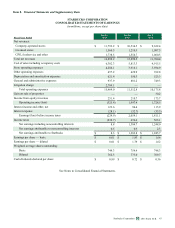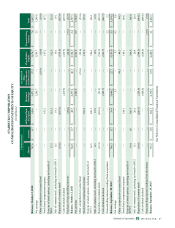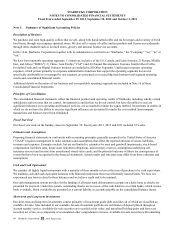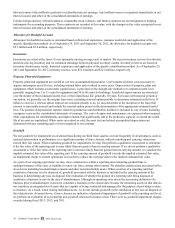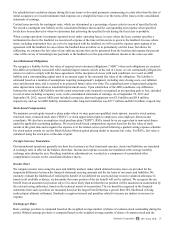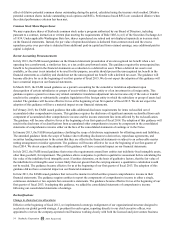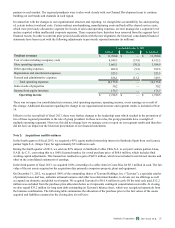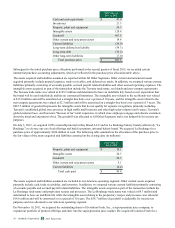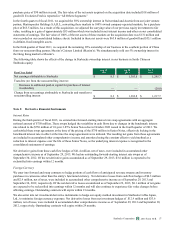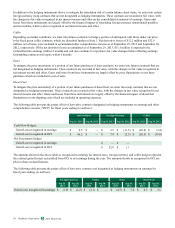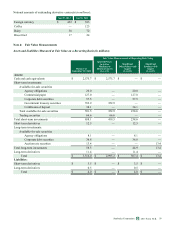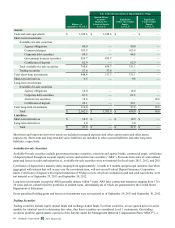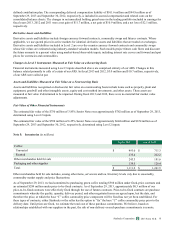Starbucks 2013 Annual Report Download - page 59
Download and view the complete annual report
Please find page 59 of the 2013 Starbucks annual report below. You can navigate through the pages in the report by either clicking on the pages listed below, or by using the keyword search tool below to find specific information within the annual report.
51
Other Intangible Assets
Other intangible assets consist primarily of trade names and trademarks with indefinite lives, which are tested for impairment
annually during the third quarter of the fiscal year, or more frequently if events or changes in circumstances indicate that assets
might be impaired. When evaluating other intangible assets for impairment, we may first perform a qualitative assessment to
determine if the fair value of the intangible asset group is more likely than not greater than its carrying amount. If we do not
perform the qualitative assessment or if the fair value of the intangible asset group is not more likely than not greater than its
carrying amount, we calculate the implied estimated fair value of the intangible asset group. If the carrying amount of the
intangible asset group exceeds the implied estimated fair value, an impairment charge to current operations is recorded to
reduce the carrying value to the implied estimated fair value.
Definite-lived intangible assets, which mainly consist of acquired rights, trade secrets, contract-based patents and copyrights,
are amortized over their estimated useful lives, and are tested for impairment when facts and circumstances indicate that the
carrying values may not be recoverable. There were no other intangible asset impairment charges recorded during fiscal 2013,
2012, and 2011.
Long-lived Assets
When facts and circumstances indicate that the carrying values of long-lived assets may not be recoverable, we evaluate long-
lived assets for impairment. We first compare the carrying value of the asset to the asset’s estimated future cash flows
(undiscounted). If the estimated future cash flows are less than the carrying value of the asset, we calculate an impairment loss
based on the asset’s estimated fair value. The fair value of the assets is estimated using a discounted cash flow model based on
forecasted future revenues and operating costs, using internal projections. Property, plant and equipment assets are grouped at
the lowest level for which there is identifiable cash flows when assessing impairment. Cash flows for company-operated store
assets are identified at the individual store level. Long-lived assets to be disposed of are reported at the lower of their carrying
amount, or fair value less estimated costs to sell.
We recognized net disposition and impairment losses of $30.1 million, $31.7 million, and $36.2 million in fiscal 2013, 2012,
and 2011, respectively. The nature of the underlying asset that is impaired will determine which operating expense line the
impairment charge is recorded in on the consolidated statements of earnings. For assets within our retail operations, net
impairment and disposition losses are recorded in store operating expenses. For all other assets, these losses are recorded in
cost of sales including occupancy costs, other operating expenses, or general and administrative expenses.
Insurance Reserves
We use a combination of insurance and self-insurance mechanisms, including a wholly owned captive insurance entity and
participation in a reinsurance treaty, to provide for the potential liabilities for certain risks, including workers’ compensation,
healthcare benefits, general liability, property insurance, and director and officers’ liability insurance. Liabilities associated with
the risks that are retained by us are not discounted and are estimated, in part, by considering historical claims experience,
demographic, exposure and severity factors, and other actuarial assumptions.
Revenue Recognition
Consolidated revenues are presented net of intercompany eliminations for wholly owned subsidiaries and investees controlled
by us and for product sales to and royalty and other fees from licensees accounted for under the equity method. Additionally,
consolidated revenues are recognized net of any discounts, returns, allowances and sales incentives, including coupon
redemptions and rebates.
Company-operated Stores Revenues
Company-operated stores revenues are recognized when payment is tendered at the point of sale. Company-operated store
revenues are reported net of sales, use or other transaction taxes that are collected from customers and remitted to taxing
authorities.
Licensed Stores Revenues
Licensed stores revenues consist of product sales to licensed stores, as well as royalties and other fees paid by licensees to use
the Starbucks brand. Sales of coffee, tea and related products are generally recognized upon shipment to licensees, depending
on contract terms. Shipping charges billed to licensees are also recognized as revenue, and the related shipping costs are
included in cost of sales including occupancy costs on the consolidated statements of earnings.
Initial nonrefundable development fees for licensed stores are recognized upon substantial performance of services for new
market business development activities, such as initial business, real estate and store development planning, as well as
providing operational materials and functional training courses for opening new licensed retail markets. Additional store
2013 10-K
Starbucks Corporation Form




